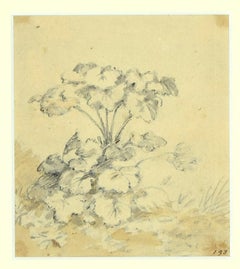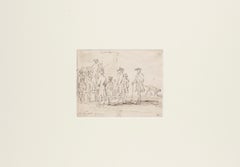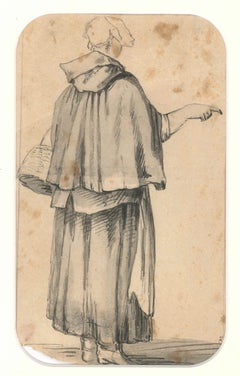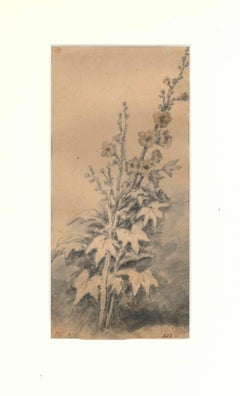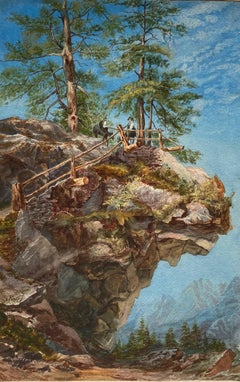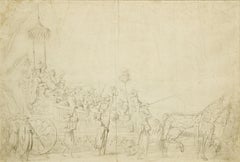18th Century Drawings and Watercolor Paintings
to
1
6
4
2
6
Overall Height
to
Overall Width
to
6
2
2
1
1
1
1
1
1
10
6
44
18
6
5
4
6
4
3
3
Period: 18th Century
Artist: Jan Pieter Verdussen
Landscape - Pencil and Watercolor by Jan Pieter Verdussen - 1750
Located in Roma, IT
Landscape is a beautiful drawing in watercolor and pencil on ivory-colored paper realized by Jan Peter Verdussen.
In good condition; only a smallspots at the edges of the drawing an...
Category
Old Masters 18th Century Drawings and Watercolor Paintings
Materials
Paper, Ink, Watercolor
Garden's Flowers - Ink and Watercolor Drawing by Jan Pieter Verdussen - 1750s
Located in Roma, IT
Garden's Flowers is a beautiful artwork realized by Jan Peter Verdussen.
In good condition.
Not signed.
Passepartout included ( 48.8 x 33.8 cm).
The artwork represents a Garden's...
Category
Old Masters 18th Century Drawings and Watercolor Paintings
Materials
Paper, Ink, Watercolor
Speech - Original China Ink Drawing by Jan Pieter Verdussen - Mid 1747
Located in Roma, IT
Speech is an original and unique drawing in ink on paper realized by Jan Peter Verdussen, with sketches on the rear.
The State of preservation is very good with the traces of time.
...
Category
Old Masters 18th Century Drawings and Watercolor Paintings
Materials
Paper, Ink
Figure of Breton Woman - Drawing by J. P. Verdussen - End of 18th Century
Located in Roma, IT
Figure of Breton Woman is a beautiful ink and watercolor original drawing on wire rod and watermarked paper realized at the middle of XVIII century by Jan Peter Verdussen.
This ori...
Category
Old Masters 18th Century Drawings and Watercolor Paintings
Materials
Paper
Turin Countryside - Original Ink and Watercolor by Jan Pieter Verdussen - 1744
Located in Roma, IT
China ink and Watercolour. With handwritten notes, indicating the place and date of the artwork in lower margin: "Fait proche de Turin, ce 13 Juin 1744". Numbered on the lower right ...
Category
Old Masters 18th Century Drawings and Watercolor Paintings
Materials
Paper, Ink, Watercolor
Flora Study - Drawing by J. P. Verdussen - End of 18th Century
Located in Roma, IT
Watercolour. Hand-Numbered "312" lower-right on margin. In very good condition except a little stain on the high left corner. Wonderful Watercolour drawing by Jan Peeter Verdussen, s...
Category
Old Masters 18th Century Drawings and Watercolor Paintings
Materials
Paper
Related Items
Josephus Augustus Knip (1777-1847), Picturesque Landscape Of The Alps
Located in PARIS, FR
Josephus Augustus KNIP
Tilbourg 1777 - Berlicum 1847
Picturesque landscape of the Alps with anthropomorphic rock
Circa 1800
Watercolor, gouache and brown ink
Signed lower left
47 x ...
Category
Old Masters 18th Century Drawings and Watercolor Paintings
Materials
Watercolor, Laid Paper
Study for « The Chinese Masquerade » by Jean-Baptiste Pierre (1714 - 1789)
By Jean-Baptiste Pierre
Located in PARIS, FR
Arriving in Rome in June 1735 as a resident at the Royal Academy, Pierre was unable to attend the Winter Carnival festivities of 1735, which he nevertheless immortalised in an engrav...
Category
Old Masters 18th Century Drawings and Watercolor Paintings
Materials
Graphite
View of the Posillipo coastline near Naples by William Marlow (1740 - 1813)
By William Marlow
Located in PARIS, FR
In this drawing, inspired by his stay in Naples in 1765, William Marlow presents us with a view of Cape Posillipo, to the west of Naples, an essential stage during the Grand Tour. Th...
Category
Old Masters 18th Century Drawings and Watercolor Paintings
Materials
Ink
La Femme Muse /// Allegorical Symbolism Romantic Old Masters European Drawing
Located in Saint Augustine, FL
Artist: Unknown (Likely French, 18th Century)
Title: "La Femme Muse"
*No signature found
Circa: 1780
Medium: Original Pastel Drawing on heavy laid paper
Frami...
Category
Old Masters 18th Century Drawings and Watercolor Paintings
Materials
Pastel, Laid Paper
It's Easier Said Than Done
Located in Denver, CO
David Rathman is known for his sensitively rendered paintings of stereotypically male motifs from American history and contemporary culture.
He was the recipient of a Bush Foundatio...
Category
Contemporary 18th Century Drawings and Watercolor Paintings
Materials
Paper, Ink, Watercolor
The Abduction of the Sabine Women , a Renaissance drawing by Biagio Pupini
Located in PARIS, FR
This vigorous drawing has long been attributed to Polidoro da Caravaggio: The Abduction of the Sabine Women is one of the scenes that Polidoro depicted between 1525 and 1527 on the façade of the Milesi Palazzo in Rome. However, the proximity to another drawing inspired by this same façade, kept at the Ecole des Beaux-Arts, and to other drawings inspired by Polidoro kept at the Musée du Louvre, leads us to propose an attribution to Biagio Pupini, a Bolognese artist whose life remains barely known, despite the abundant number of drawings attributed to him.
1. Biagio Pupini, a Bolognese artist in the light of the Roman Renaissance
The early life of Biagio Pupini, an important figure of the first half of the Cinquecento in Bologna - Vasari mentions him several times - is still poorly known. Neither his date of birth (probably around 1490-1495) nor his training are known. He is said to have been a pupil of Francesco Francia (1450 - 1517) and his name appears for the first time in 1511 in a contract with the painter Bagnacavallo (c. 1484 - 1542) for the frescoes of a church in Faenza. He then collaborated with Girolamo da Carpi, at San Michele in Bosco and at the villa of Belriguardo.
He must have gone to Rome for the first time with Bagnacavallo between 1511 and 1519. There he discovered the art of Raphael, with whom he might have worked, and that of Polidoro da Caravaggio. This first visit, and those that followed, were the occasion for an intense study of ancient and modern art, as illustrated by his abundant graphic production.
Polidoro da Caravaggio had a particular influence on the technique adopted by Pupini. Executed on coloured paper, his drawings generally combine pen, brown ink and wash with abundant highlights of white gouache, as in the drawing presented here.
2. The Abduction of the Sabine Women
Our drawing is an adaptation of a fresco painted between 1525 and 1527 by Polidoro da Caravaggio on the façade of the Milesi Palace in Rome. These painted façades were very famous from the moment they were painted and inspired many artists during their stay in Rome. These frescoes are now very deteriorated and difficult to see, as the palace is in a rather narrow street.
The episode of the abduction of the Sabine women (which appears in the centre of the photo above) is a historical theme that goes back to the origins of Rome and is recounted both by Titus Livius (Ab Urbe condita I,13), by Ovid (Fasti III, 199-228) and by Plutarch (II, Romulus 14-19). After killing his twin brother Romus, Romulus populates the city of Rome by opening it up to refugees and brigands and finds himself with an excess of men. Because of their reputation, none of the inhabitants of the neighbouring cities want to give them their daughters in marriage. The Romans then decide to invite their Sabine neighbours to a great feast during which they slaughter the Sabines and kidnap their daughters.
The engraving made by Giovanni Battista Gallestruzzi (1618 - 1677) around 1656-1658 gives us a good understanding of the Polidoro fresco, allowing us to see how Biagio Pupini reworked the scene to extract this dynamic group.
With a remarkable economy of means, Biagio Pupini takes over the left-hand side of the fresco and depicts in a very dense space two main groups, each consisting of a Roman and a Sabine, completed by a group of three soldiers in the background (which seems to differ quite significantly from Polidoro's composition).
The balance of the drawing is based on a very strongly structured composition. The drawing is organised around a median vertical axis, which runs along both the elbow of the kidnapped Sabine on the left and the foot of her captor, and the two main diagonals, reinforced by four secondary diagonals. This diamond-shaped structure creates an extremely dynamic space, in which centripetal movements (the legs of the Sabine on the right, the arm of the soldier on the back at the top right) and centrifugal movements (the arm of the kidnapper on the left and the legs of the Sabine he is carrying away, the arm of the Sabine on the right) oppose each other, giving the drawing the appearance of a whirlpool around a central point of support situated slightly to the left of the navel of the kidnapper on the right.
3. Polidoro da Caravaggio, and the decorations of Roman palaces
Polidoro da Caravaggio was a paradoxical artist who entered Raphael's (1483 - 1520) workshop at a very young age, when he oversaw the Lodges in the Vatican. Most of his Roman work, which was the peak of his career, has disappeared, as he specialised in facade painting, and yet these paintings, which are eminently visible in urban spaces, have influenced generations of artists who copied them abundantly during their visits to Rome.
Polidoro Caldara was born in Caravaggio around 1495-1500 (the birthplace of Michelangelo Merisi, known as Caravaggio, who was born there in 1571), some forty kilometres east of Milan. According to Vasari, he arrived as a mason on the Vatican's construction site and joined Raphael's workshop around 1517 (at the age of eighteen according to Vasari). This integration would have allowed Polidoro to work not only on the frescoes of the Lodges, but also on some of the frescoes of the Chambers, as well as on the flat of Cardinal Bibiena in the Vatican.
After Raphael's death in 1520, Polidoro worked first with Perin del Vaga before joining forces with Maturino of Florence (1490 - 1528), whom he had also known in Raphael's workshop. Together they specialised in the painting of palace façades. They were to produce some forty façades decorated with grisaille paintings imitating antique bas-reliefs.
The Sack of Rome in 1527, during which his friend Maturino was killed, led Polidoro to flee first to Naples (where he had already stayed in 1523), then to Messina. It was while he was preparing his return to the peninsula that he was murdered by one of his assistants, Tonno Calabrese, in 1543.
In his Vite, Vasari celebrated Polidoro as the greatest façade decorator of his time, noting that "there is no flat, palace, garden or villa in Rome that does not contain a work by Polidoro". Polidoro's facade decorations, most of which have disappeared as they were displayed in the open air, constitute the most important lost chapter of Roman art of the Cinquecento. The few surviving drawings of the painter can, however, give an idea of the original appearance of his murals and show that he was an artist of remarkable and highly original genius.
4. The façade of the Milesi Palace
Giovanni Antonio Milesi, who commissioned this palace, located not far from the Tiber, north of Piazza Navona, was a native of the Bergamo area, like Polidoro, with whom he maintained close friendly ties. Executed in the last years before the Sack of Rome, around 1526-1527, the decoration of Palazzo Milesi is considered Polidoro's greatest decorative success.
An engraving by Ernesto Maccari made at the end of the nineteenth century allows us to understand the general balance of this façade, which was still well preserved at the time. The frescoes were not entirely monochrome, but alternated elements in chiaroscuro simulating marble bas-reliefs and those in ochre simulating bronze and gold vases...
Category
Old Masters 18th Century Drawings and Watercolor Paintings
Materials
Ink, Gouache, Pen
Costume drawings for ‘Ambassadeur de Siam’ and ‘La Sultana Reine’
Located in Amsterdam, NL
Joseph-Marie Vien (1716-1809)
‘Ambassadeur de Siam’ and ‘La Sultana Reine’
Both titled lower centre, the drawing of the ambassador inscribed with colours intended for the prints, e...
Category
Old Masters 18th Century Drawings and Watercolor Paintings
Materials
Paper, Pencil
Free Shipping
H 9.26 in W 6.89 in D 1.19 in
Follower of Francesco Guardi, Figures in a Mediterranean port by a Roman Arch
By Francesco Guardi
Located in Harkstead, GB
A lively, well executed sketch painted by a 19th century follower of Francesco Guardi
Follower of Francesco Guardi, 19th Century
Figures by a Roman Arch
Watercolour with ink and sc...
Category
Old Masters 18th Century Drawings and Watercolor Paintings
Materials
Paper, Ink, Watercolor
Free Shipping
H 6.5 in W 5 in D 1 in
Fine 1700's Italian Old Master Ink & Wash Drawing Roman Allegorical Insubria
Located in Cirencester, Gloucestershire
'Insubria'
Italian School, 18th century
ink and wash drawing on paper, framed within a light oak wood frame (behind glass)
image size: 10.5 x 7 inches
overall framed: 17 x 13 inches
...
Category
Old Masters 18th Century Drawings and Watercolor Paintings
Materials
Ink, Watercolor, Archival Paper
French School, Academic Study (Male Nude)
Located in London, GB
Charcoal on paper, 60cm x 42cm, (74cm x 60cm framed). The picture is framed behind museum quality non-reflective UV glass.
Drawings and paintings of the nude were central to academ...
Category
Old Masters 18th Century Drawings and Watercolor Paintings
Materials
Paper, Carbon Pencil
Fine 1700's Italian Old Master Ink & Wash Drawing Roman Allegorical Figure Fame
Located in Cirencester, Gloucestershire
'Fame'
Italian School, 18th century
ink and wash drawing on paper, framed within a light oak wood frame (behind glass)
image size: 10.5 x 7 inches
overall framed: 17 x 13 inches
cond...
Category
Old Masters 18th Century Drawings and Watercolor Paintings
Materials
Watercolor, Archival Paper, Ink
Pavilion with waterfall, an ink wash attributed to Hubert Robert (1733 - 1808)
By Hubert Robert
Located in PARIS, FR
This large wash drawing is a slightly enlarged version of a composition executed by Hubert Robert in 1761, at the end of his stay in Rome. This composition is a marvellous synthesis of the painter's art: the clatter of the waterfall, in a grandiose setting inspired by antiquity, is opposed to the intimacy of a genre scene, made up of a few peasant women performing some agricultural work.
1. The stay in Italy, an important founding stage in Hubert Robert's carrier
Hubert Robert came from a privileged family of Lorraine origin, linked to the Choiseul-Stainville family, where his father was an intendant. The protection of this powerful aristocratic family enabled him to study classical art at the Collège de Navarre (between 1745 and 1751). After a first apprenticeship in the workshop of the sculptor Slodtz (1705 - 1764), he was invited by Etienne-François de Choiseul-Beaupré-Stainville (the future Duke of Choiseul, then Count of Stainville) to join him in Rome when the latter had just been appointed ambassador.
Hubert Robert arrived in Rome on 4 November 1754, aged twenty-one, and remained there until 24 July 1765. Thanks to his patron, he obtained a place as a pensioneer at the Académie de France without having won the prestigious Prix de Rome. On his arrival in Rome, he frequented the studio of the painter Giovanni Paolo Panini (1691 - 1765), the inventor of the ruins painting, and also benefited from the proximity of Giovanni Battista Piranesi’s studio (1720 - 1778). During his eleven-year stay in Rome, Hubert Robert studied the great Italian masters and drew many of the great archaeological sites, multiplying the sketches which he would use throughout his career, becoming one of the masters of the "ruin landscape".
Back in Paris in 1765, he was very successful. He was accepted and admitted to the Royal Academy of Painting and Sculpture on the same day, July 26th 1766, which was very unusual. He was appointed draughtsman of the king's gardens in 1784, then guard of the Royal Museum from 1784 to 1792. Arrested in 1793 and detained in the prisons of Sainte Pélagie and Saint-Lazare, he was released in 1794 after the fall of Robespierre and undertook a second trip to Italy. In 1800, Hubert Robert was appointed curator of the new Central Museum and died at his home in Paris in 1808.
2. Description of the artwork
This composition, formerly called "La Cascade du Belvédère Pamphile" , is undoubtedly inspired by the water theatres of the Frascati villas. Hubert Robert presents a hemicycle of columns with rustic bossages at the foot of which is a cascade of water falls into a basin. The hemicycle is flanked by two high walls, pierced by window wells topped with antique masks...
Category
Old Masters 18th Century Drawings and Watercolor Paintings
Materials
Ink, Watercolor
Recently Viewed
View AllMore Ways To Browse
Folly Drawing
Vintage Ink Pen
Antique Japanese Watercolor Painting
Golfers Watercolor
Japanese Pen And Ink Drawings
Golf Watercolor
19th Century Charcoal Portrait
Charcoal Drawing Portraits Early 20th Century
Unsigned Pastel Drawing
Retro Shell Poster
Nicholson Ben
Orchid Drawing
Golf Watercolor Art
Cubist Charcoal Drawing
Ballerina Drawing
Watercolor Cape Cod
Skeleton Drawing
Graphite Botanicals

